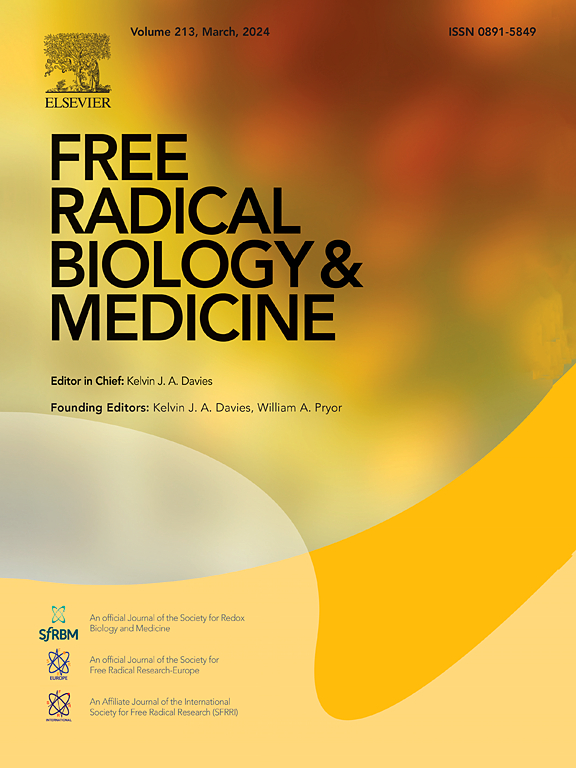新型非共价硫氧还蛋白还原酶抑制剂对三阴性乳腺癌的多效抗癌作用。
IF 7.1
2区 生物学
Q1 BIOCHEMISTRY & MOLECULAR BIOLOGY
引用次数: 0
摘要
越来越多的证据表明,肿瘤的生长和进展依赖于硫氧还蛋白还原酶1 (TXNRD1)介导的氧化应激解毒,这是肿瘤中代谢和有丝分裂信号失调造成的。TXNRD1水平在三阴性乳腺癌(TNBC)中显著高于正常组织,使TXNRD1成为令人信服的TNBC治疗靶点。尽管许多尝试产生TXNRD1抑制剂,所有已知和报道的化合物抑制TXNRD1是有问题的;它们与TXNRD1不可逆且非特异性地相互作用,导致许多不良副作用。最近,一系列突破性的研究发现了曼氏血吸虫硫氧还蛋白谷胱甘肽还原酶的一个新的调控位点“门阻口袋”,这是一种类似txnrd的酶,也是人类寄生虫感染血吸虫病的一个确定的药物靶点。这一发现为该酶家族开发新的一流非共价抑制剂奠定了基础。我们的数据表明,新型非共价TXNRD抑制剂(TXNRD(i)s)是TNBC细胞模型中有效的剂量依赖性活性抑制剂。TXNRD(i)可以减弱TNBC细胞中几种侵袭性癌症表型,如克隆生存、乳腺球形成效率、侵袭性和TXNRD相关基因表达。TXNRD(i)在活TNBC细胞和异种移植肿瘤中参与并抑制TXNRD1,从而在细胞水平上支持其作用机制。更重要的是,TXNRD(i)在临床前MDA-MB-231 TNBC异种移植小鼠模型中抑制肿瘤生长。虽然还需要进一步优化TXNRD(i)的效力,但这些结果可能为开发新型小分子治疗TNBC开辟了新的途径。本文章由计算机程序翻译,如有差异,请以英文原文为准。

Pleiotropic anti-cancer activities of novel non-covalent thioredoxin reductase inhibitors against triple negative breast cancer
Mounting evidence shows that tumor growth and progression rely on thioredoxin reductase 1 (TXNRD1)-mediated detoxification of oxidative stress that results from deregulated metabolism and mitogenic signaling in tumors. TXNRD1 levels are significant higher in triple negative breast cancer (TNBC) compared to normal tissue, making TXNRD1 a compelling TNBC therapeutic target. Despite the many attempts to generate TXNRD1 inhibitors, all known and reported compounds inhibiting TXNRD1 are problematic; they interact with TXNRD1 irreversibly and non-specifically resulting in numerous adverse side effects. Recently, a series of breakthrough studies identified a novel regulatory site, the ‘doorstop pocket’, in Schistosoma mansoni thioredoxin glutathione reductase, a TXNRD-like enzyme and an established drug target for the human parasitic infection, schistosomiasis. This discovery underpins the development of new first-in-class non-covalent inhibitors for this family of enzymes.
Our data show that novel non-covalent TXNRD inhibitors (TXNRD(i)s) are potent dose-dependent inhibitors of viability in cellular models of TNBC. TXNRD(i)s attenuate several aggressive cancer phenotypes such as, clonogenic survival, mammosphere forming efficiency, invasion, and TXNRD-related gene expression in TNBC cells. TXNRD(i)s engage and inhibit TXNRD1 in live TNBC cells and xenograft tumors, thus supporting the mechanism of action at a cellular level. More importantly, TXNRD(i)s attenuated tumor growth in a preclinical MDA-MB-231 TNBC xenograft mouse model. Although additional optimization for TXNRD(i)s’ potency is warranted, these results may open a new avenue for the development of novel small molecule therapeutics for TNBC.
求助全文
通过发布文献求助,成功后即可免费获取论文全文。
去求助
来源期刊

Free Radical Biology and Medicine
医学-内分泌学与代谢
CiteScore
14.00
自引率
4.10%
发文量
850
审稿时长
22 days
期刊介绍:
Free Radical Biology and Medicine is a leading journal in the field of redox biology, which is the study of the role of reactive oxygen species (ROS) and other oxidizing agents in biological systems. The journal serves as a premier forum for publishing innovative and groundbreaking research that explores the redox biology of health and disease, covering a wide range of topics and disciplines. Free Radical Biology and Medicine also commissions Special Issues that highlight recent advances in both basic and clinical research, with a particular emphasis on the mechanisms underlying altered metabolism and redox signaling. These Special Issues aim to provide a focused platform for the latest research in the field, fostering collaboration and knowledge exchange among researchers and clinicians.
 求助内容:
求助内容: 应助结果提醒方式:
应助结果提醒方式:


